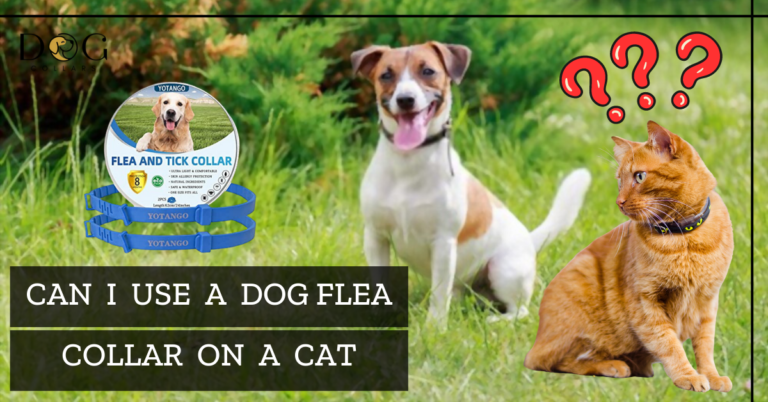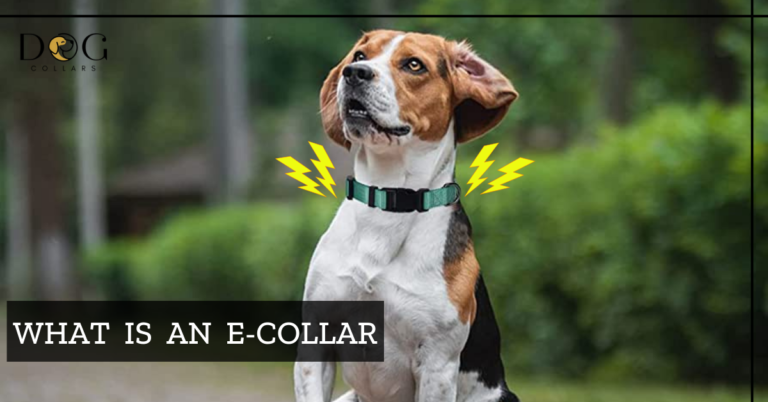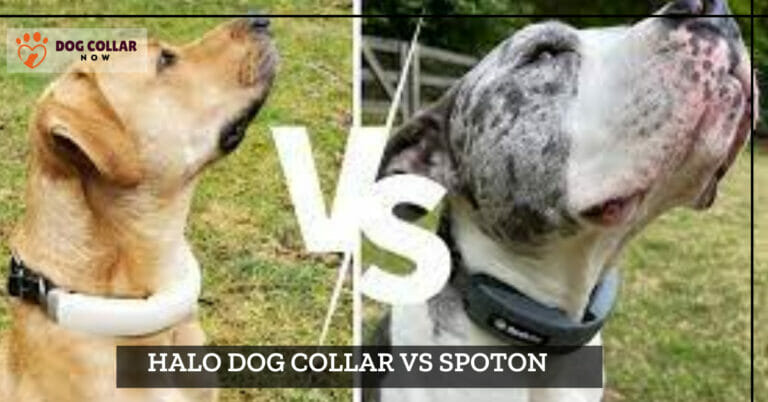Dog Tick Collar Vs Drops – Decoding the Epic Clash

Confused about which option to choose for tick control? Discover the pros and cons: Dog Tick Collar vs Drops.
As pet owners, we always want the best for our furry companions. However, dog tick collars and drops are effective methods for tick control, but they have different application methods and considerations.
The main difference between dog tick collars and drops is the application method. Collars are worn around the dog’s neck and release tick-repellent chemicals, while drops are liquid solutions applied directly to the dog’s skin.
Now, we’ll explore the differences between these two products so you can decide which one is best for your pet!
Dog Tick Collar Vs Drops – What’s The Difference Between
The main difference between these products lies in their mode of application. Dog tick collars offer long-lasting protecting for several months without requiring re-application; however, they may cause irritation to some dogs’ skin due to the pesticide content present in them.
Dog tick collars and drops are two ways to protect your dog from flea and tick infestations. While both have the same goal, they work in distinct ways.
1. Application Method:
Tick Collar:
A dog tick collar is worn around your pet’s neck like any other collar, containing active ingredients that repel ticks and fleas.
Tick Drops:
On the other hand, dog tick drops are topical treatments applied directly on your pet’s skin between its shoulder blades or down its spine. These drops contain pesticides that kill adult fleas and prevent eggs from hatching for a specified period.
2. Mode of Action:
Tick Collar:
Tick collars release repellent chemicals that create a protective barrier on the dog, repelling ticks and reducing the risk of bites.
Tick Drops:
Tick drops are applied to the dog’s skin and contain chemicals that kill ticks. These chemicals enter the bloodstream, eliminating ticks when they bite and preventing infestation.
3. Duration of Effectiveness:
Tick Collar:
Tick collars offer extended protection, lasting for weeks to months. The collar steadily releases repellent chemicals, providing continuous defense against ticks for your dog.
Tick Drops:
Tick drops’ effectiveness varies by brand and formulation. Duration of protection ranges from weeks to months, requiring regular reapplication for sustained effectiveness.
4. Suitability and Convenience:
Tick Collar:
Tick collars are suitable for dogs of all sizes and ages. They’re easy to use and require minimal effort. Ideal for dogs resistant to topical applications or for hands-off tick control.
Tick Drops:
Tick drops work for dogs of different sizes and ages. They require precise application and handling. Some dogs may resist the process, making it challenging for both dog and owner.
In contrast, dog tick drops require a monthly application but don’t usually cause any discomfort to pets as it doesn’t come into contact with the skin once applied correctly.
Ultimately, whether you choose a collar or drop depends on your preference and what works best for your furry friend!
Dog tick collar
Pros:
Dog tick collars are a popular choice for pet owners who want to protect their dogs from ticks and fleas.
There are several benefits of using dog tick collars, which we will discuss below.
- Dog tick collars offer long-lasting protection, up to 8 months, with continuous effectiveness and no additional effort required.
- They are easy to use, simply adjust and put them around your dog’s neck, making them convenient for busy pet owners.
- Dog tick collars are waterproof, maintaining their effectiveness even when wet or during baths.
- Many collars contain natural ingredients, providing pest repellent without harsh chemicals or pesticides, promoting the safety of your pet.
There are several benefits associated with using a dog tick collar as opposed to other forms of flea prevention such as sprays, shampoos, or topical treatments.
However, it’s important to note that not all products work equally well on every pet. So make sure you choose one based on your individual needs and preferences!
Cons:
Dog tick collars are a popular option among pet owners because they provide long-lasting protection against ticks and fleas.
However, there are some cons of using a dog tick collar that you should know before making your decision.
- Use of pesticides can be harmful if not used properly.
- Potential for causing skin irritation and allergic reactions in some dogs.
- Limited effectiveness against parasite eggs and larvae.
- Some dogs may find wearing a collar uncomfortable and stressful.
- Consider alternative options such as topical treatments or sprays if your dog dislikes wearing a collar.
- While dog tick collars have their benefits when it comes to preventing fleas and ticks, there are also several drawbacks associated with their use that should be taken into consideration before making a purchase decision for your beloved pooch.
Types of dog tick collars:
There are four main types of dog tick collars available in the market. Each type has its own unique mechanism to repel ticks and fleas.
Traditional flea collar:
This type is known as the traditional flea collar. These collars use a pesticide to kill adult fleas and prevent further infestation. They work by emitting insecticides that spread throughout your pet’s coat, killing any parasites that come into contact with it.
Ultrasonic flea and tick collar:
This type of collar emits a high-pitched frequency that repels insects without harming your pet. It works by interfering with their nervous system, making them uncomfortable enough to stay away from your furry friend.
Herbal flea collar:
This type of collar is made from natural ingredients such as citronella, eucalyptus oil, or lavender oil. These collars are free from pesticides but have a less potent effect on reducing flea infestations compared to other types of dog tick collars.
Seresto collar:
A long-lasting option designed for dogs who love water activities like swimming or bathing frequently. The active ingredient in this collar releases slowly over time providing protection for up to 8 months against ticks and fleas.
Choosing the right dog tick collar depends on various factors including breed, age, weight, activity level, and environment so make sure you consult with your veterinarian before deciding which one will work best for your furry friend!
How To Choose The Tick Collar For Your Pet?
When it comes to choosing a tick collar for your pet, there are several factors that you should consider.
- Make sure that the collar is specifically designed for dogs and not for other animals such as cats or rabbits.
- Take into account the size of your dog. There are different sizes of tick collars available in the market so choose one that fits your furry friend comfortably without being too tight or loose.
- Another important factor to consider is the type of active ingredient used in the collar. Some collars use pesticides while others use natural ingredients like essential oils. Do some research about these ingredients and their effectiveness before making a choice.
- Make sure to also check if your dog has any allergies or reactions to certain substances as this could cause irritation when wearing the collar.
- Consider how long you want protection against ticks and fleas. Some collars provide protection for up to 8 months, while others only last for a few weeks or months.
By taking all of these factors into account, you can make an informed decision on which tick collar will work best for your beloved pet.
Dog flea and tick drops
Pros:
Dog tick drops are a popular and effective way to prevent flea and tick infestations on your furry friend.
Here are some of the pros of using dog tick drops:
- Easy to apply topically without causing discomfort to your pet.
- Quick and effective against adult fleas and ticks.
- Some products have long-lasting effects to prevent re-infestation.
- Can repel other pests, such as mosquitoes and biting flies.
- No irritation or discomfort around the neck area.
- Convenient packaging options available.
Dog tick drops offer an efficient way to keep fleas and ticks at bay while being easy to apply and gentle on your furry friend’s skin.
Cons:
Dog tick drops may not be the ideal choice for every dog owner.
- Can cause irritation or allergic reactions in some dogs.
- Contains pesticides that can pose health risks if not used properly.
- Requires direct application onto the pet’s skin, which can be challenging.
- Some dogs may not tolerate topical application well, causing stress.
While there are certainly benefits associated with using dog tick drops, it’s equally important to consider these possible downsides before deciding whether this method of parasite control is right for your canine companion.
Types of dog tick drop:
Types of dog tick drops can vary depending on the active ingredient used.
Spot-on treatment:
The most common types are topical flea treatments, or spot-on solutions, which are applied directly onto the dog’s skin. These products contain insecticides that kill adult fleas and ticks upon contact.
Oral medication:
The other type of tick drop is an oral medication that requires your pet to swallow a chewable tablet. These medications work by circulating in your pet’s bloodstream and killing ticks from the inside out.
Esential oils and sprays or shampoo:
There are also natural alternatives to chemical-based tick drops such as essential oil sprays or shampoos that repel ticks with scents like lemon, lavender, eucalyptus, or peppermint.
Before choosing a product for your pup, it’s important to consider their age and weight as some products may not be suitable for puppies or small dogs.
Moreover, always check with your veterinarian before administering any new flea and tick treatment to ensure it is safe for your furry friend.
What to consider before buying tick drops?
When it comes to purchasing tick drops for your dog, there are several factors that you should consider before making a decision.
- The first thing to keep in mind is the age and weight of your pet, as certain products may only be suitable for dogs over a certain size or age.
- It is important to consider the active ingredients in the tick drops. Different products may contain different pesticides that work in various ways to repel or kill ticks.
- It’s essential to research each product and consult with your veterinarian about which one would be best suited for your dog’s needs.
- You should also consider how often you will need to apply the tick drops, as some require weekly application while others can last up to a month.
- In addition, some products may not be safe for use on pregnant or nursing dogs, so it’s important to carefully read all labels and instructions before administering any treatment.
By taking all these factors into account when selecting a tick drop product for your furry companion, you can help ensure their safety and effectively protect them against fleas and ticks.
Personal recommendations
When deciding between a dog tick collar and drops, consider these important factors: the active ingredient’s effectiveness, your pet’s size, history of allergies, and the severity of the infestation.
Personal recommendations from other dog owners and online reviews from verified purchasers can provide valuable insights.
However, keep in mind that every dog is unique, so consulting with your veterinarian is crucial to choose a safe and effective treatment. Make an informed decision to keep your furry friend protected!
Conclusion
When choosing between a dog tick collar and drops, consider effectiveness, comfort, and application convenience. Collars offer long-lasting protection but may cause irritation. Drops provide targeted treatment but can be messy. Seresto collar is popular for effectiveness and water resistance. Consult vet for suitable drops. Regular application and good hygiene are essential for pet’s well-being.
FAQs:
Are flea and tick collars better than pills?
Flea and tick collars and pills are both effective at killing these parasites. However, collars provide longer-lasting protection while pills offer faster results. The choice between the two depends on personal preference and the level of infestation.
Are flea collars as effective as drops?
Flea collars are effective for repelling fleas and ticks, but not as effective as drops for killing them. The chemicals in flea collars are not as potent and long-lasting as those in drops.
Do tick drops work?
Tick drops can be an effective method for preventing ticks from infesting dogs and cats. These drops contain chemicals that kill ticks or prevent them from attaching to the animal’s skin.
Is a tick collar better than frontline?
While both tick collars and Frontline have their advantages, studies have shown that tick collars are more effective in long-term prevention. However, it is recommended to consult with a veterinarian to determine the most appropriate prevention method for your pet.
How fast do tick collars work?
Tick collars typically start working immediately after application, but it can take up to 48 hours before they become fully effective. The collar releases a chemical which spreads over the pet’s skin and fur, killing and repelling ticks for several months.








